With the group activities continuously expanding as we try to further enhance countryside and wildlife survival prospects, pausing to recount the achievements has to take second place to the tasks themselves. This means that there have been less reports produced than normal to keep supporters abreast with group work. For this we apologise. In an attempt to redress this, we include the following group activity update as the first step to catch up with our work achievements.
GROUP ANNUAL GENERAL MEETING AND TALK.
On May 30th we held our annual general meeting to discuss group business that had taken place over the last year. At this meeting we said a fond farewell to our treasurer, Terry Harper, who had been a valuable supporter since the group began in 2004 and latterly group treasurer for at least a decade. During this time he had steered the group finances to allow full visibility of funds and accommodating the multitude of costs and payments necessary to keep group progress moving forward efficiently. For this we had become very dependent on his expertise, so when he reluctantly decided that he would like to leave the role for health reasons, we were deeply saddened.
We therefore showed our gratitude for the huge time and effort he had contributed to the group by presenting him with a gift of glasses engraved with owls as a token of our appreciation. The picture below shows the gift being presented.
 Our valued friend and supporter, Terry Harper being presented with a token of our appreciation for his years of service to The Woodland, Flora & Fauna Group.
Our valued friend and supporter, Terry Harper being presented with a token of our appreciation for his years of service to The Woodland, Flora & Fauna Group.
Following our AGM we held a public talk for our supporters which was provided by the naturalist, author and wildlife guide, Michael Blencowe. It was well attended and received by the audience, as shown below.
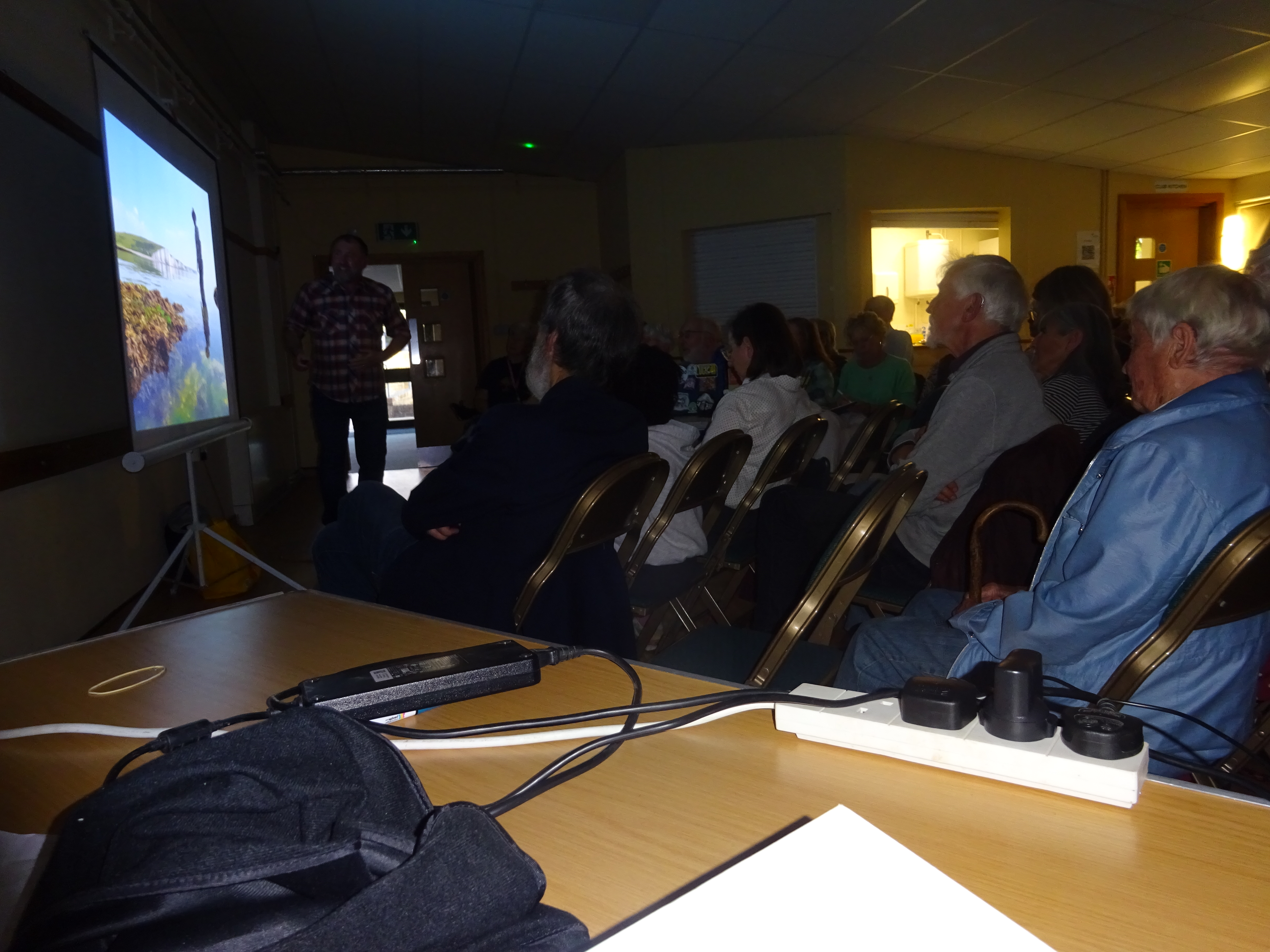 Michael Blencowe gave a talk on The Wildlife of Sussex to the attendees of the event.
Michael Blencowe gave a talk on The Wildlife of Sussex to the attendees of the event.
TALBOT FIELD NATURE AREA.
Following our earlier clearance work this year undertaken at Talbot Field Small Nature Area in Hassocks, some areas of the meadow were cleared and wildflower plugs planted. The existing grass was so thick, that to give the plugs a chance of survival, the turf had to be removed. This was not easy, but gave the plants better chance to flourish. The downside of this was the amount of attention required to keep them alive during the very hot spells that occurred this summer, with constant visits to water them and repair damage caused by local wildlife and passing dogs.
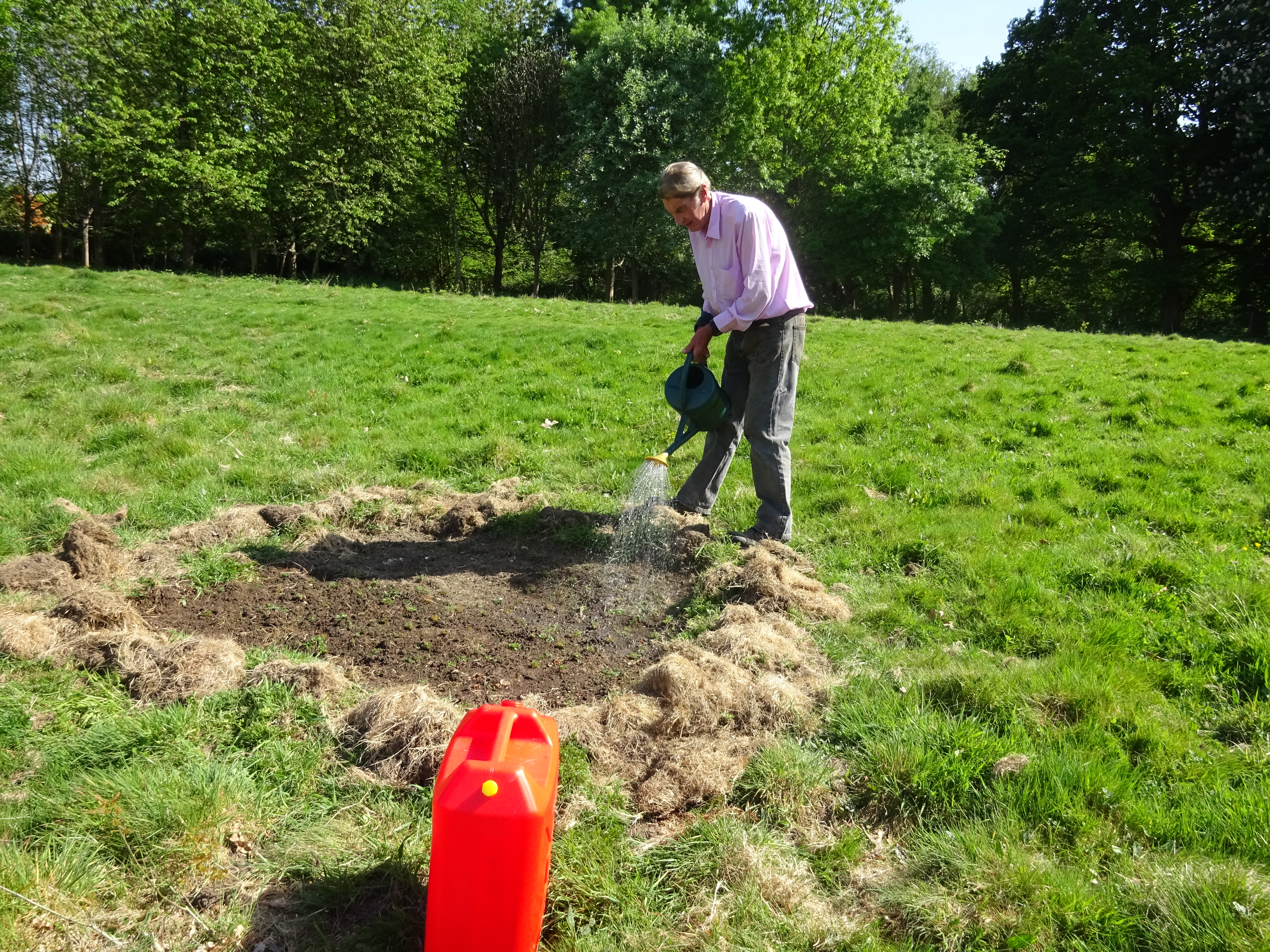 Many water runs were required to keep the plants alive in the hot weather.
Many water runs were required to keep the plants alive in the hot weather.
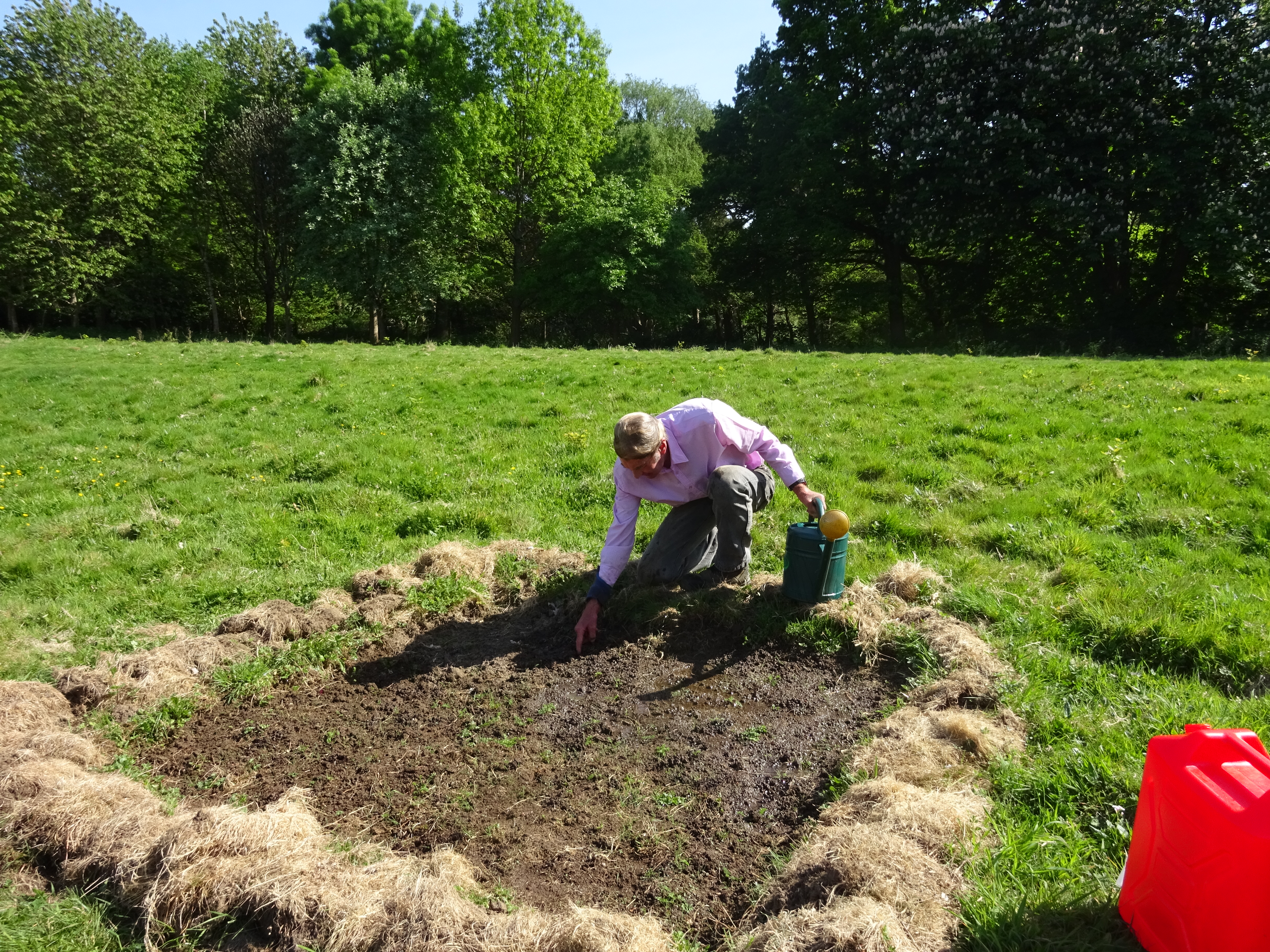 Damage caused by passing dogs scratching plugs out of the ground, scavenging rabbits and burrowing moles had to be repaired on each visit. Any covering of protective sticks applied tended to be used by dog walkers to throw for their dogs to retrieve, so are no longer used.
Damage caused by passing dogs scratching plugs out of the ground, scavenging rabbits and burrowing moles had to be repaired on each visit. Any covering of protective sticks applied tended to be used by dog walkers to throw for their dogs to retrieve, so are no longer used.
Despite this unwanted animal attention, a good number survived to add to the floral richness of the meadow.
BERRYLANDS POND.
Earlier this year The Woodland, Flora & Fauna Group assumed responsibility for another site to further the prospects for nature in our local area, and began work at Berrylands Pond in Sayers Common. The area had been a longstanding source of complaint from local residents due to its overgrown state which to many had become an eyesore. The maintenance of this pond was the responsibility of Mid Sussex District Council, but due to funding pressures and staff shortages, it had become neglected. With complaints rising and the council unable to find a solution, Hurstpierpoint & Sayers Common Parish Council asked our group if we could take over the maintenance of the site and improve its value for nature.
We were aware that not all residents had the same vision for the transformation outcome, and whatever we did would please some but not others. This was a different scenario to all our other nature sites where the results sought were primarily for nature enhancement and improvement for the survival prospects of wildlife. After due consideration we agreed, and are pursuing a strategy to make it visually more appealing to local residents, whilst boosting the site’s nature credentials. We listened to the differing opinions of many of the residents and are steering a course of achieving our objectives for the pond area, and embracing as many of the comments as possible. Our volunteers, who include some of the Sayers Common residents, are working hard to achieve this.
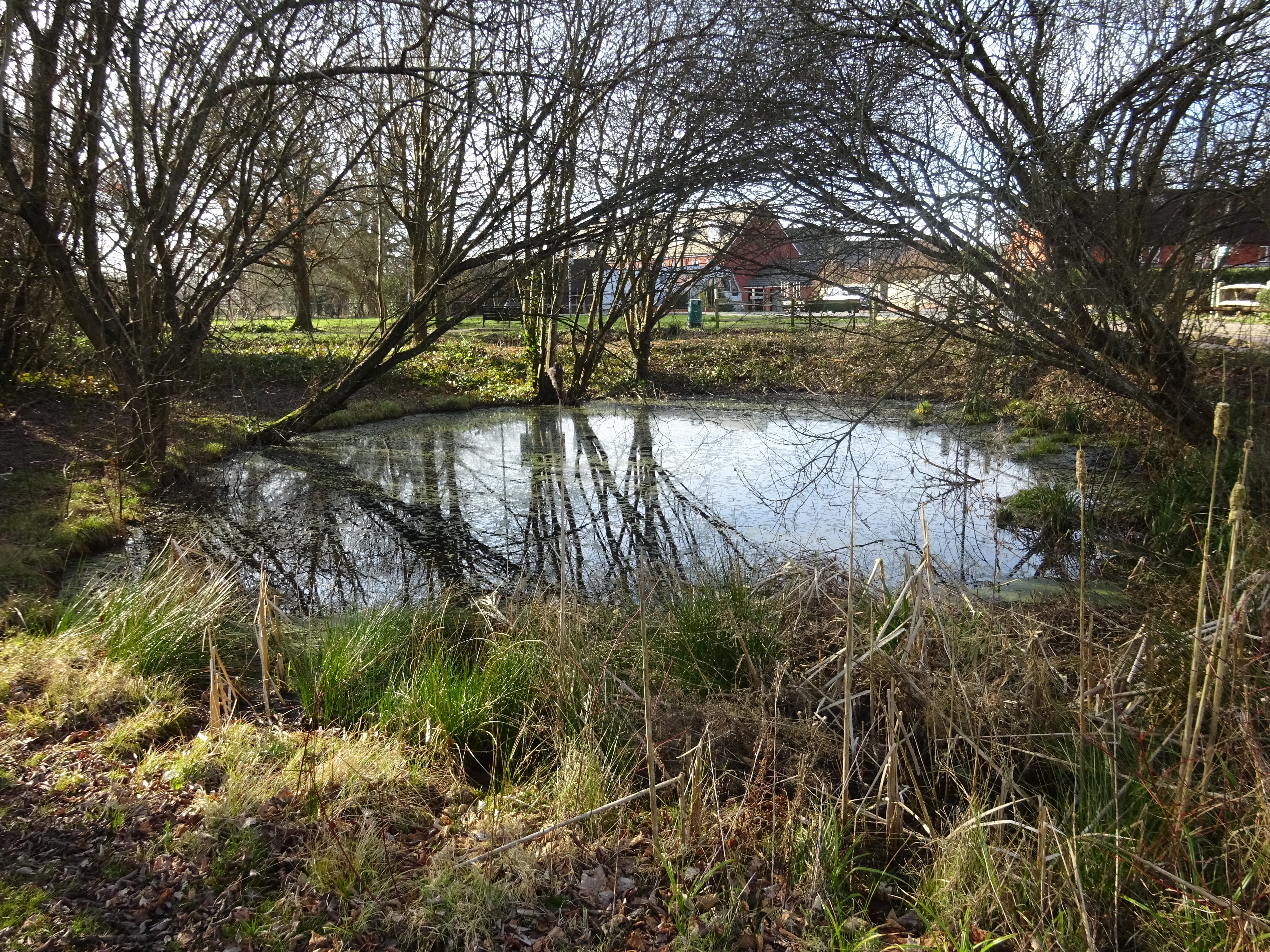 This was the pond area as it was presented to us.
This was the pond area as it was presented to us.
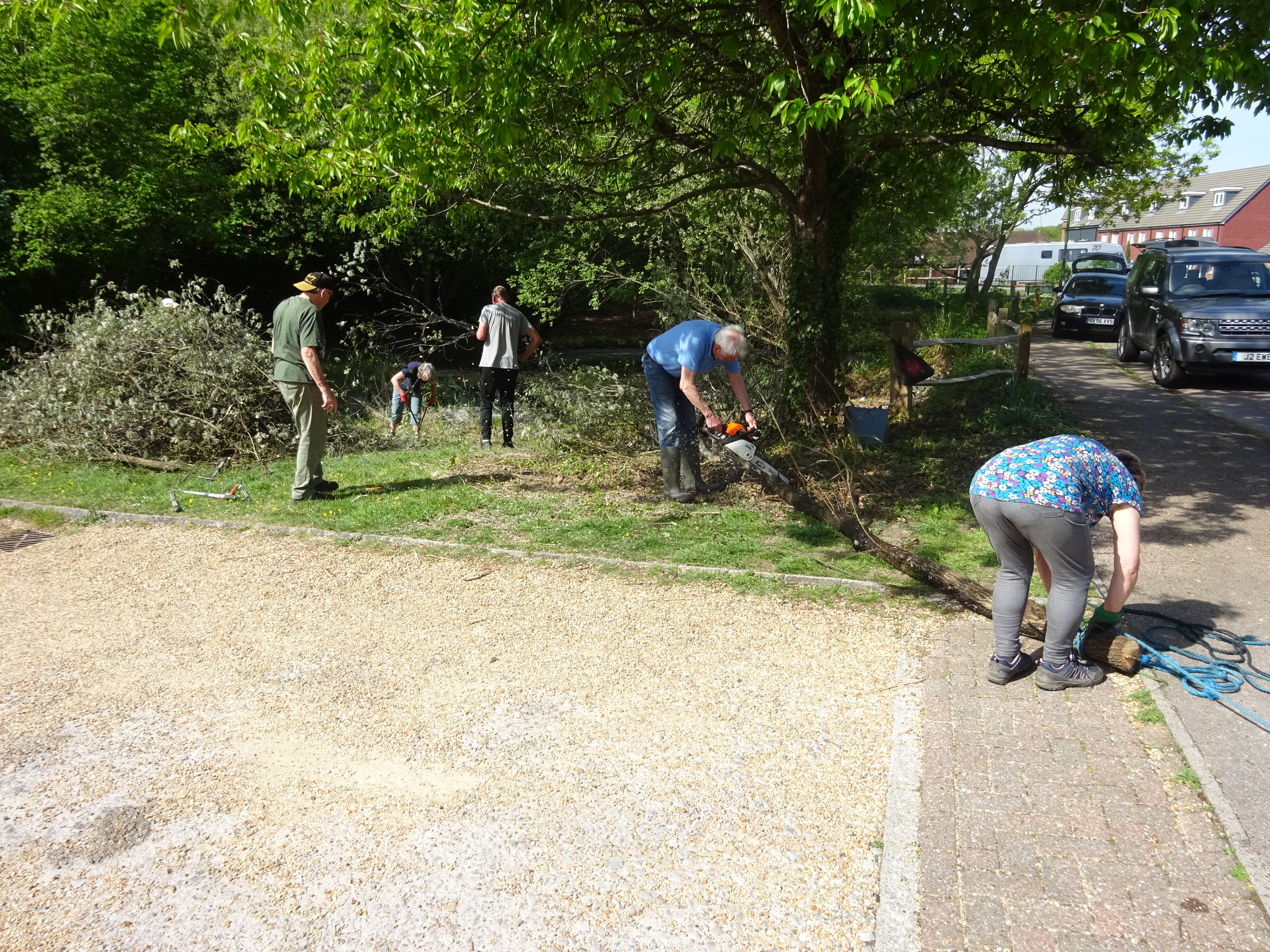 Volunteers worked hard to improve the site for nature.
Volunteers worked hard to improve the site for nature.
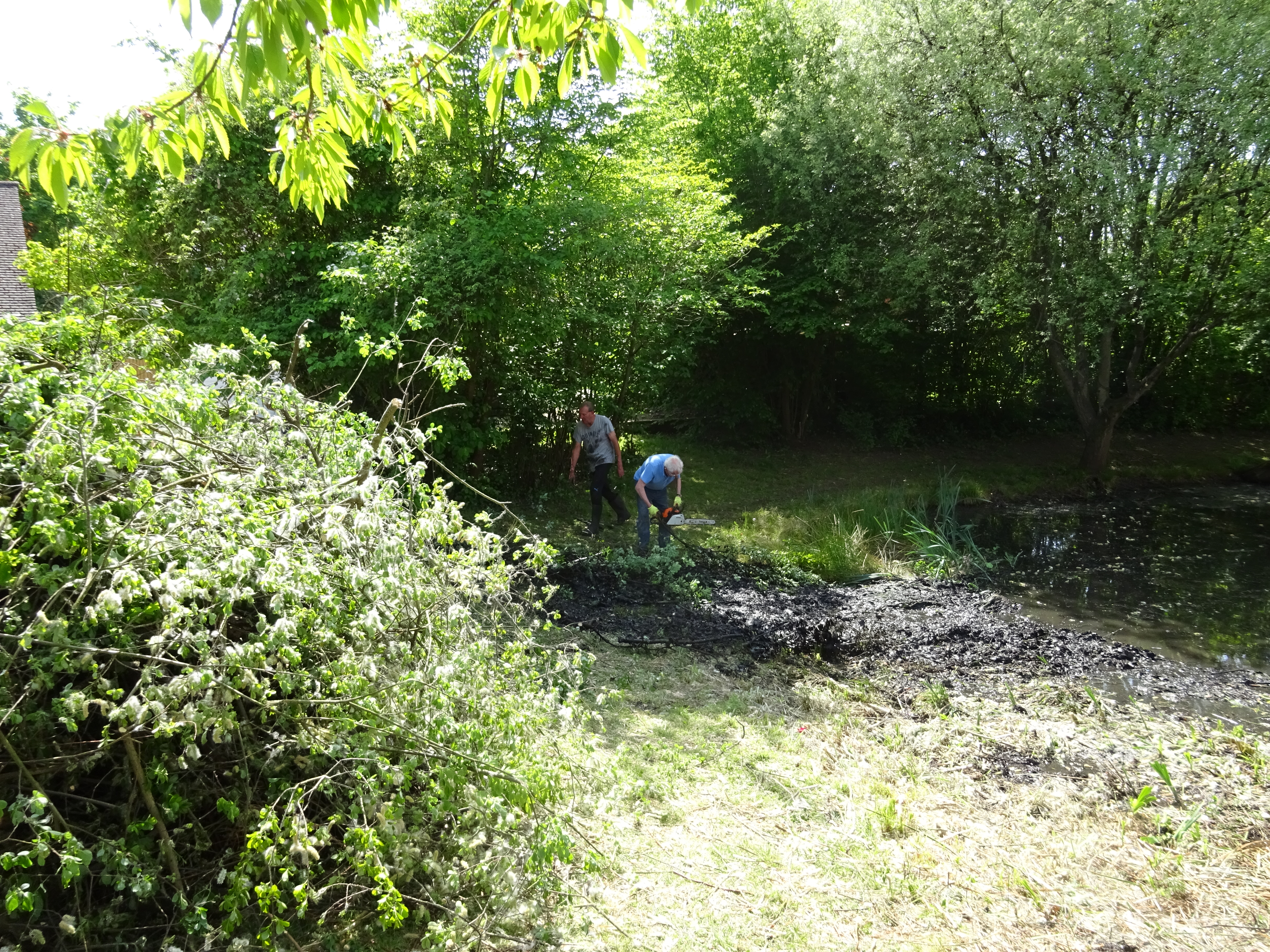 All debris produced was piled into a stack for later removal by MSDC contractors as site disposal in a built-up area of housing was not an option.
All debris produced was piled into a stack for later removal by MSDC contractors as site disposal in a built-up area of housing was not an option.
Work there has continued to generally tidy the site and remove falling or leaning trees across the pond to allow more light to penetrate.
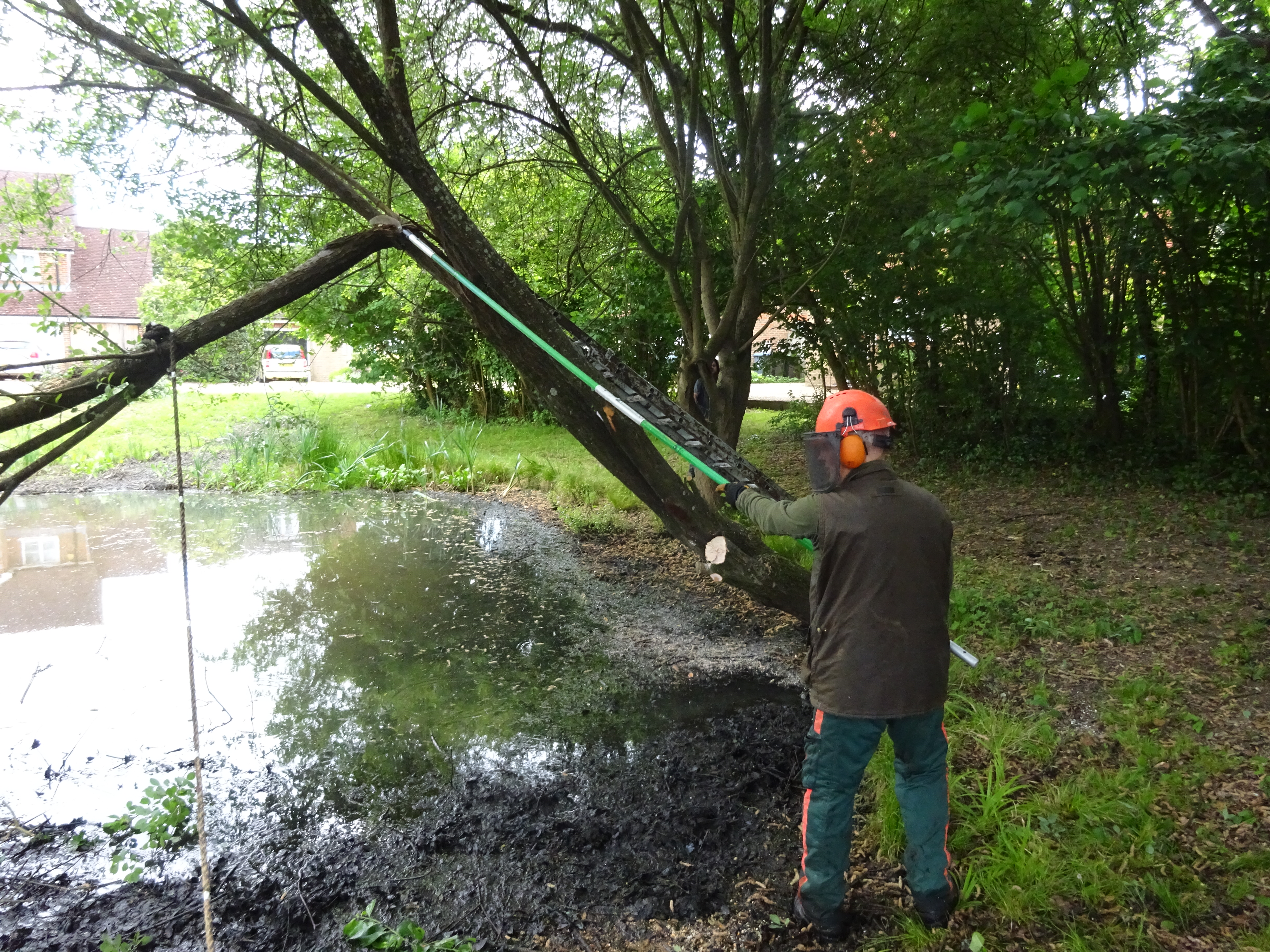 Work was undertaken to allow more light penetration into the pond, as shown here.
Work was undertaken to allow more light penetration into the pond, as shown here.
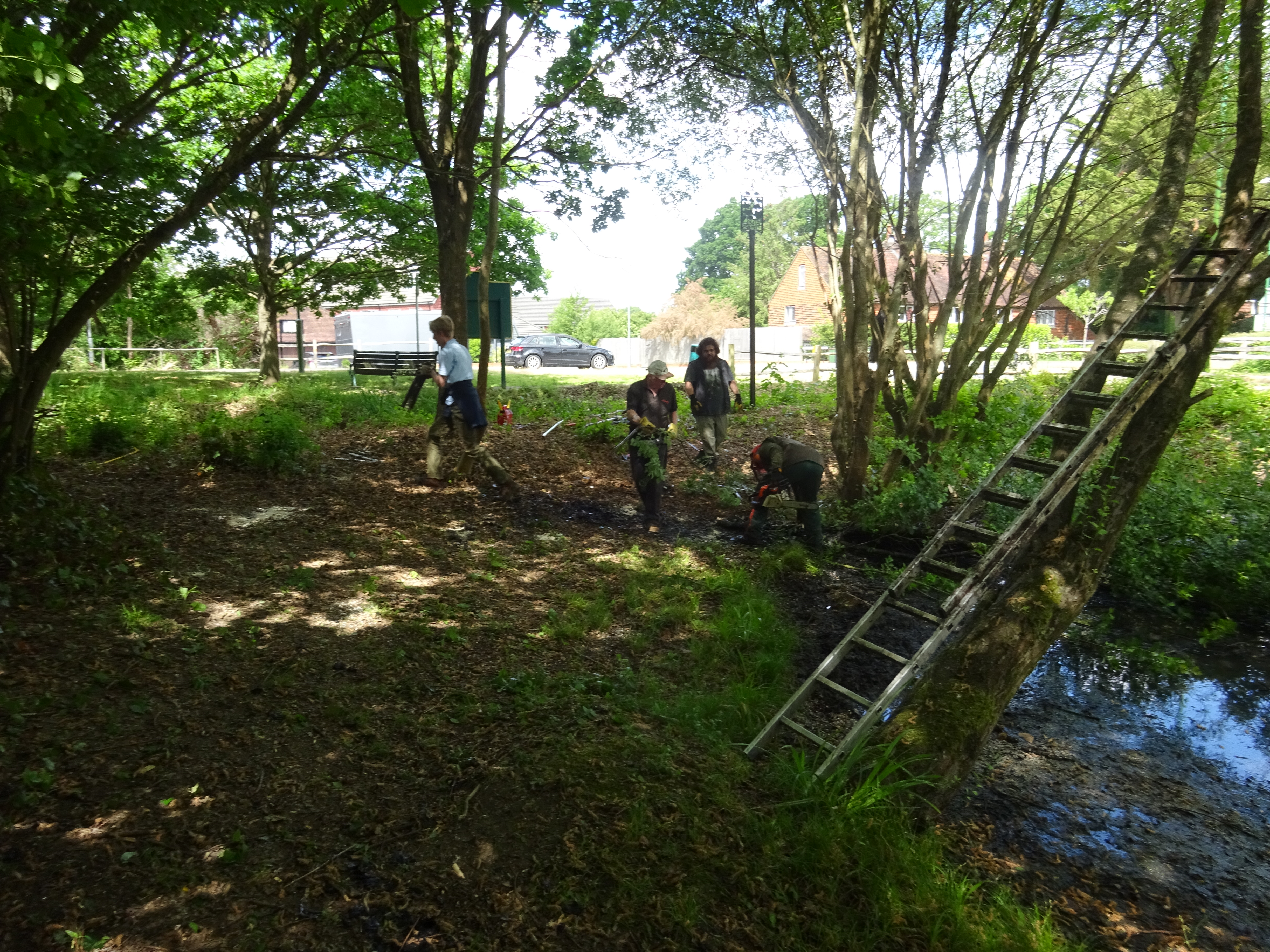 With most of the cut branches falling into the pond, ropes had to be tied around them before they were cut, so that they could be hauled to the banks for disposal.
With most of the cut branches falling into the pond, ropes had to be tied around them before they were cut, so that they could be hauled to the banks for disposal.
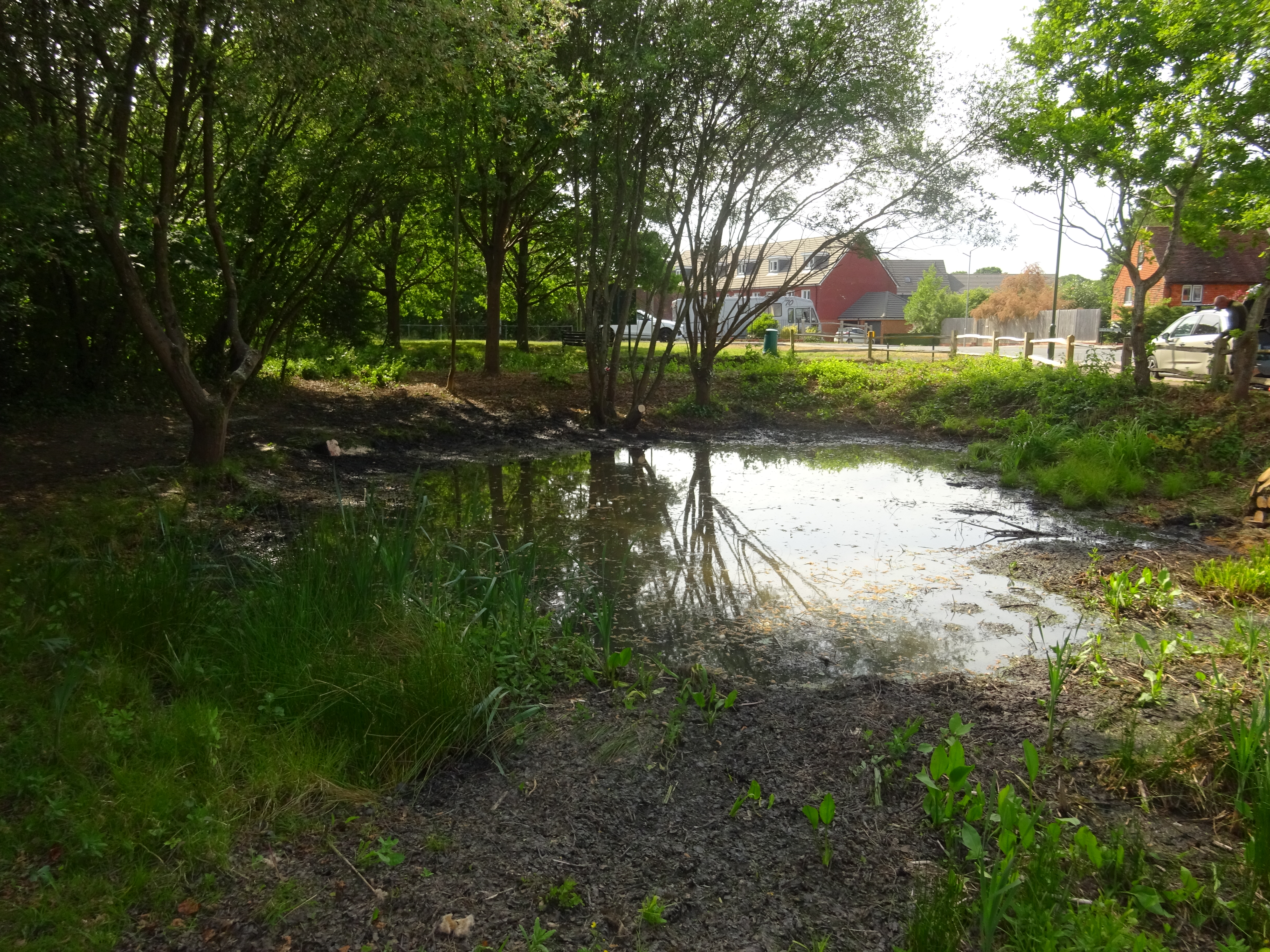 This was how the pond appeared when the overhanging tree growth was removed.
This was how the pond appeared when the overhanging tree growth was removed.
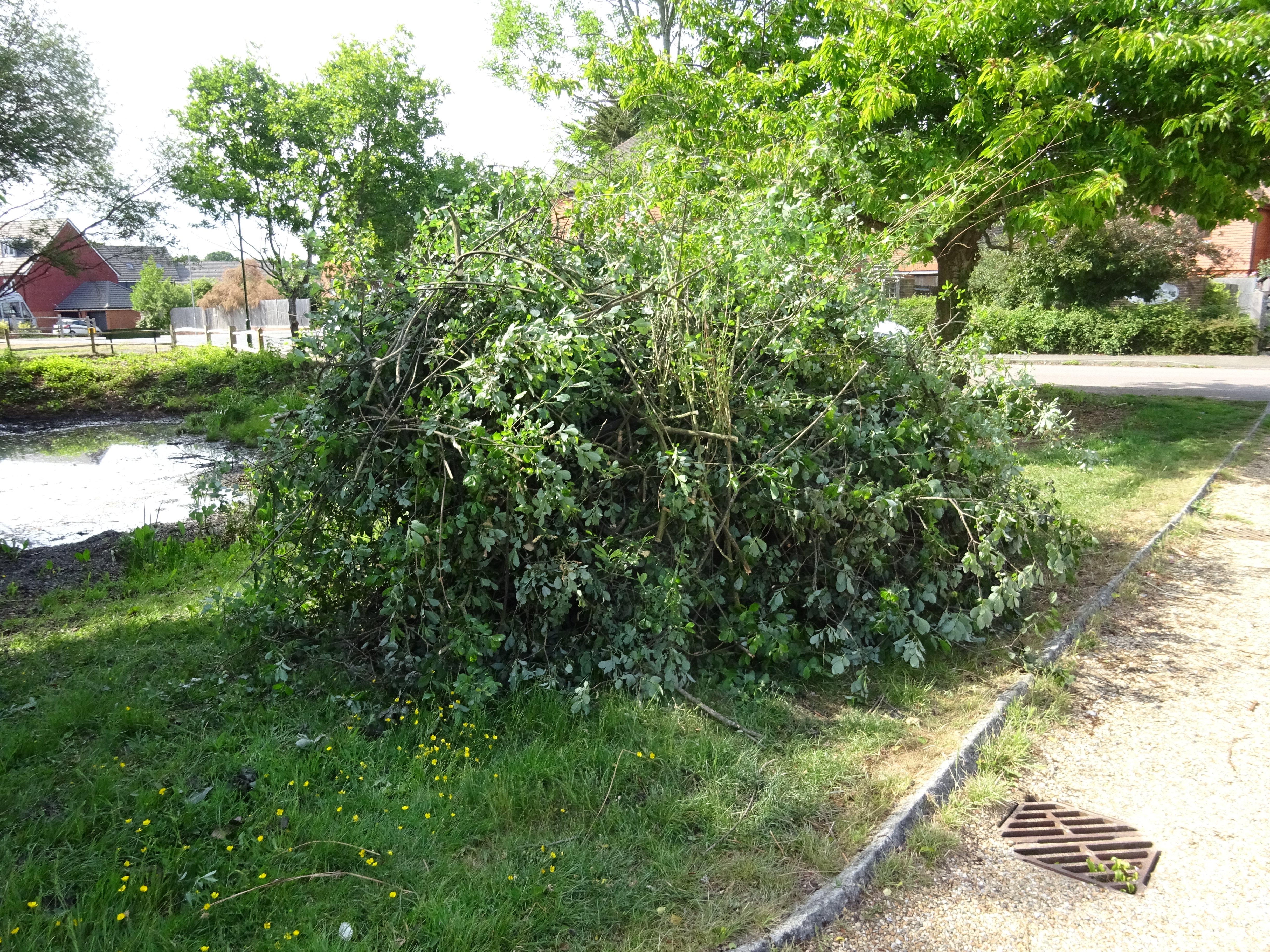 All twigs and small branches were again heaped for later removal by council contractors, and all main branch sections were stacked in a wildlife wood pile in one corner of the site.
All twigs and small branches were again heaped for later removal by council contractors, and all main branch sections were stacked in a wildlife wood pile in one corner of the site.
With the water level in the pond receding due to the hot weather as the work progressed, the organisation of the next work phase became increasingly important. A large amount of silt, mostly consisting of rotting organic matter from fallen leaves was appearing, emphasising the need for dredging to be carried out to restore the pond to its original depth.
To achieve this, The Woodland,Flora & Fauna Group have obtained quotations from specialist companies, for the pond to be dredged and the silt removed. These quotations have been passed to Hurstpierpoint and Sayers Common Parish Council for consideration and approval of costs, which will be borne by MSDC funding. A response is still awaited.
Since then, further work requested by residents in neighbouring properties has been undertaken, to lower the height of some of the trees around the pond to provide more visibility of it.
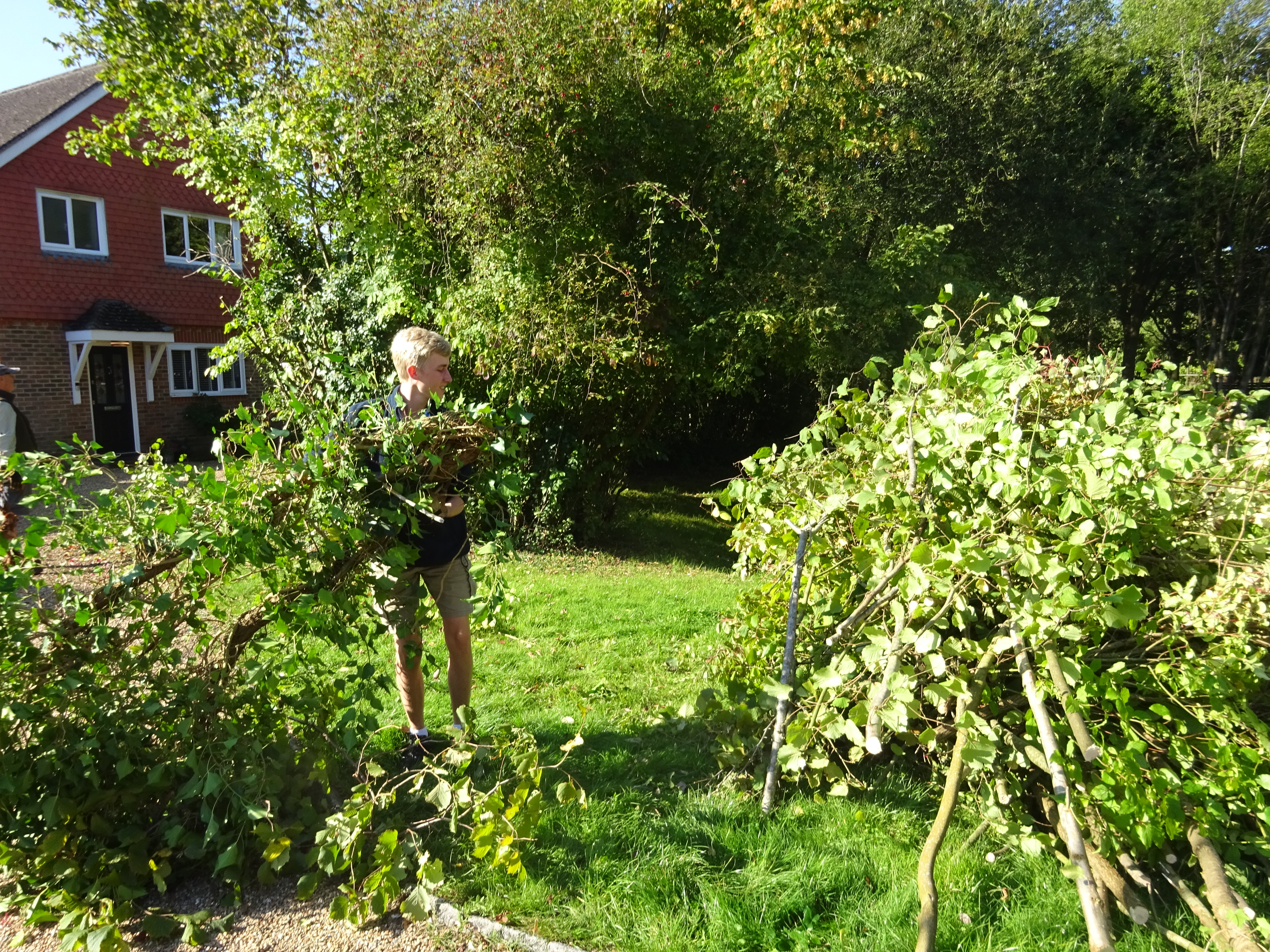 Volunteers again attended while waiting for the dredging response from MSDC, to reduce the height of surrounding trees.
Volunteers again attended while waiting for the dredging response from MSDC, to reduce the height of surrounding trees.
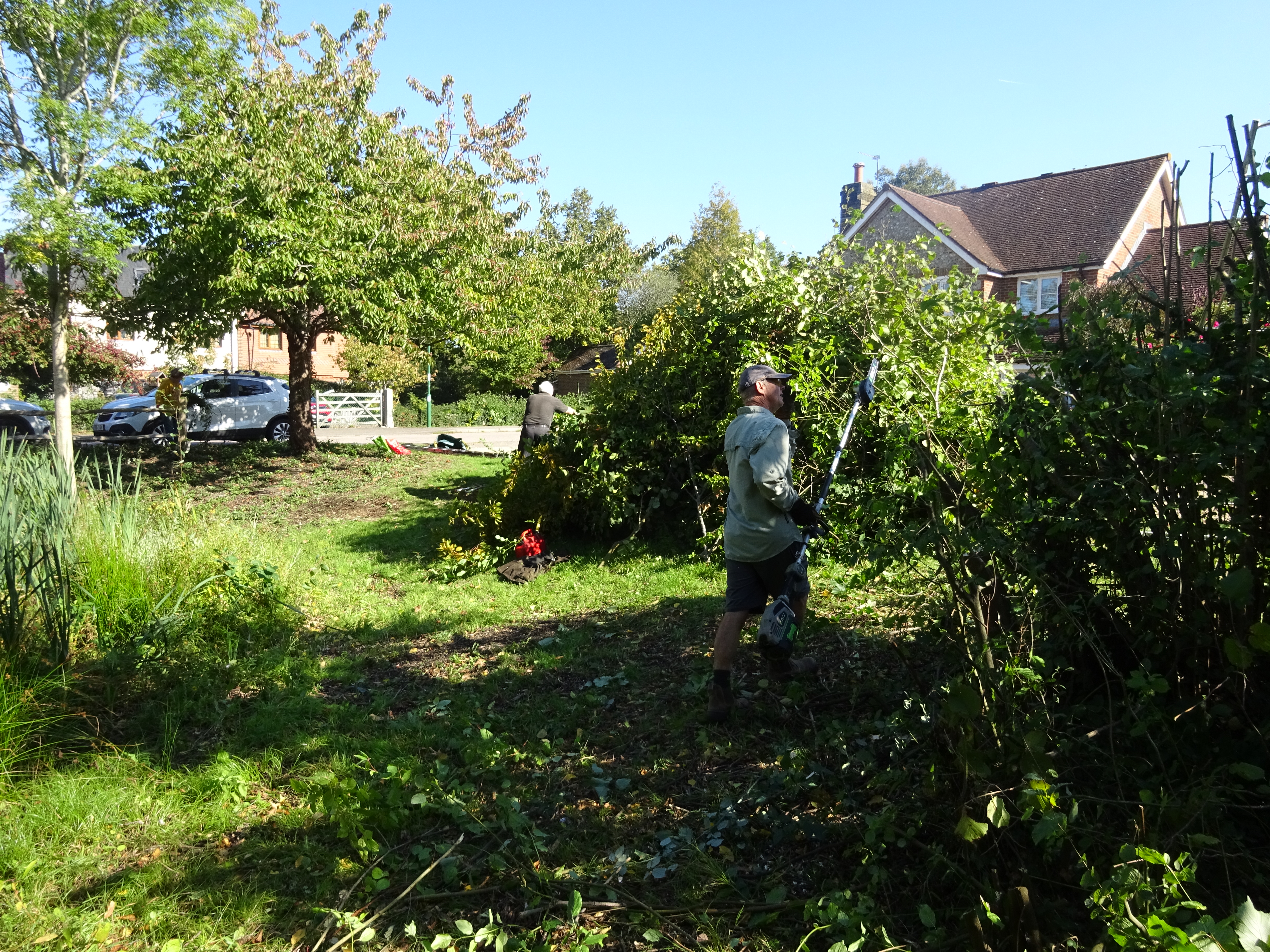 The result allowed even more light to penetrate the pond area.
The result allowed even more light to penetrate the pond area.
GROUP ATTENDANCE AT COUNCIL AGM.
Group members once again set up a publicity stall at the Hurstpierpoint & Sayers Common Parish Council AGM in the early summer to advertise our work and achievements.
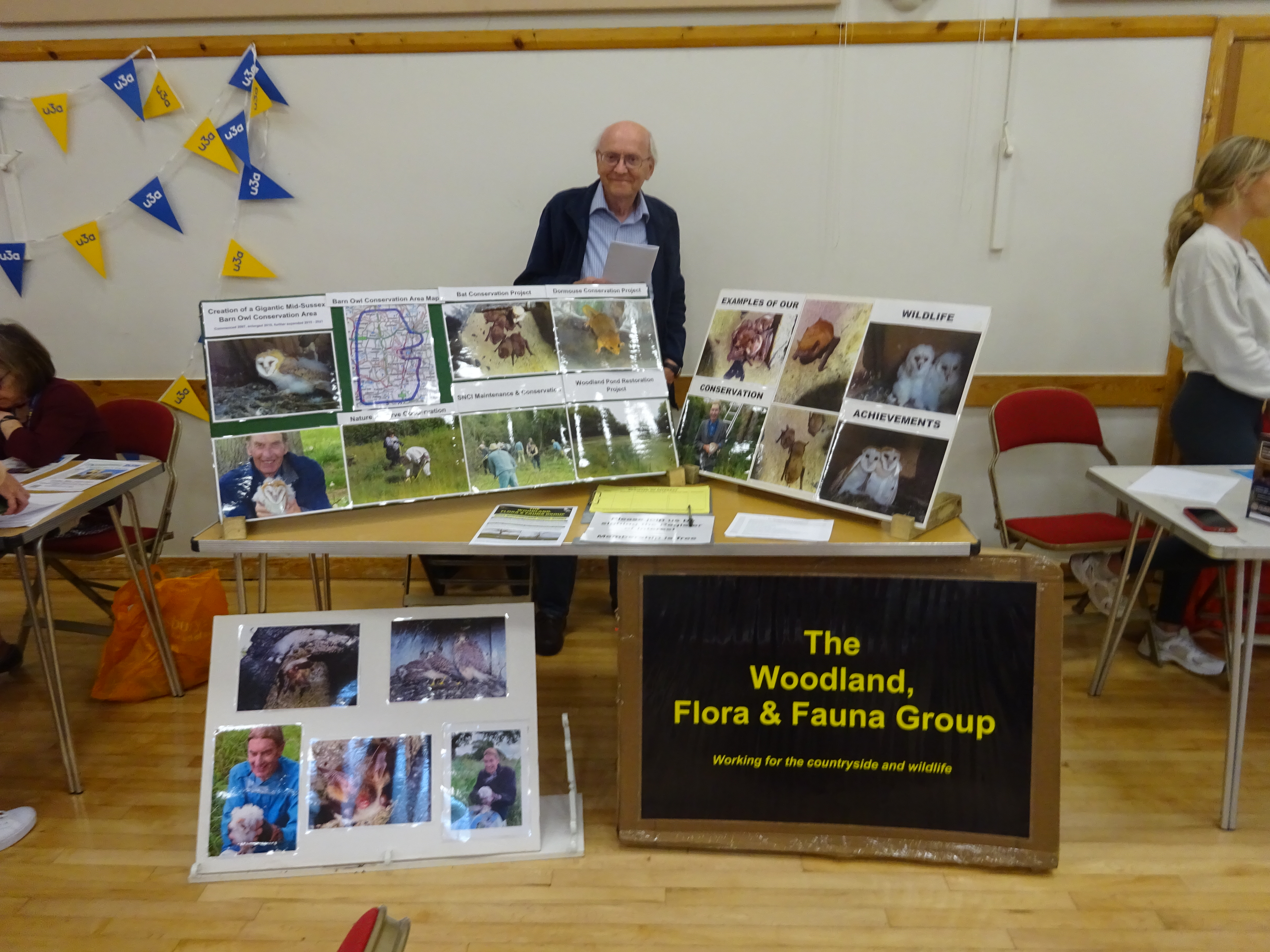 Photo boards highlighted group’s achievements at the event.
Photo boards highlighted group’s achievements at the event.
POND LYE SITE OF NATURE CONSERVATION IMPORTANCE.
Our calendar is dictated by seasonal demands, so we were then required to direct our attention to the meadow area at Pond Lye which was becoming punctuated with emerging ragwort and thistle. These species are normally not a problem if controlled, but both generate anxiety and complaints when viewed by neighbours. We therefore returned to ensure they did not cause any problems in this respect, and to prepare the site for the meadow cut scheduled for late summer.
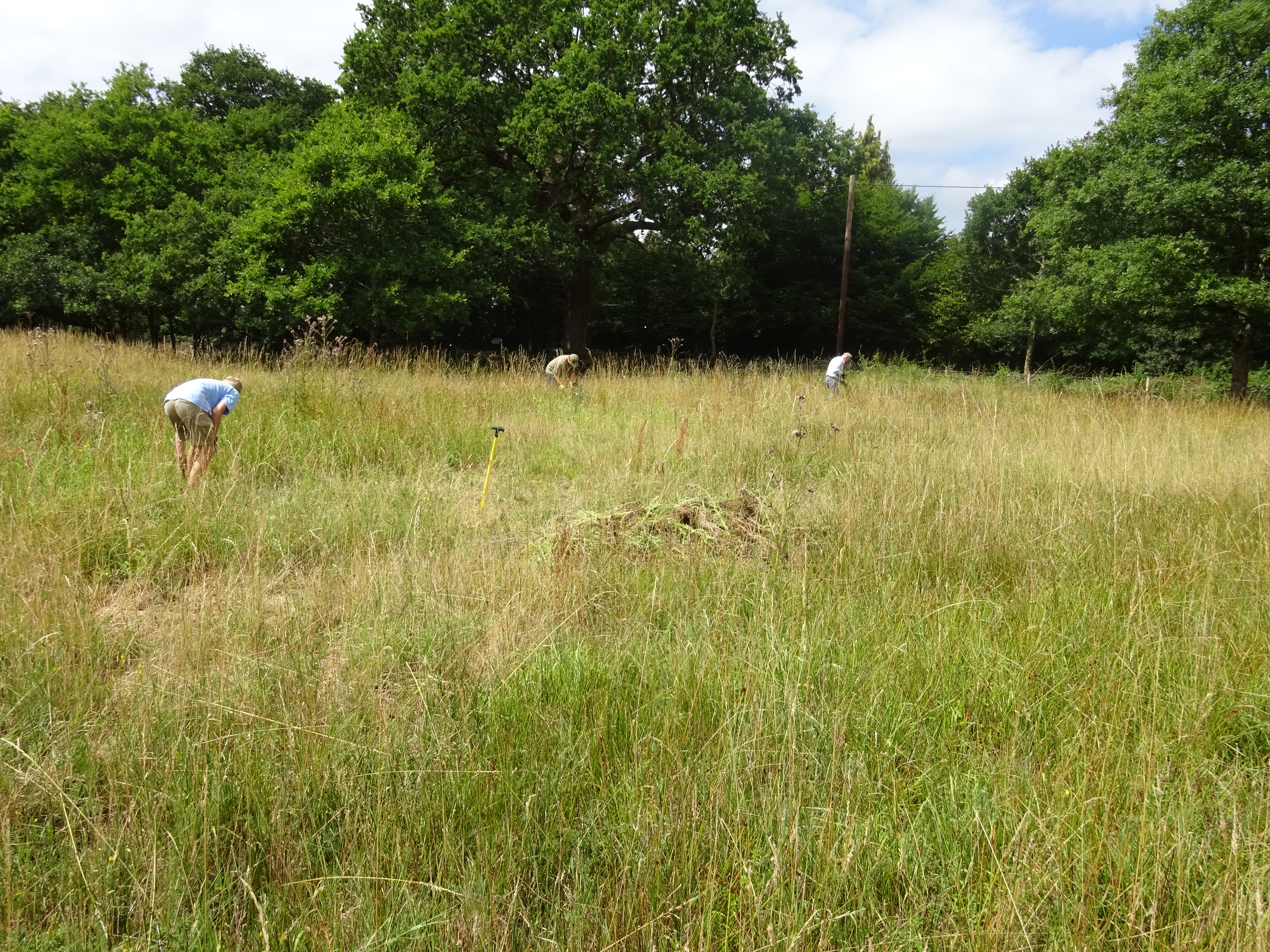 Ragwort and thistles were diligently removed by volunteers.
Ragwort and thistles were diligently removed by volunteers.
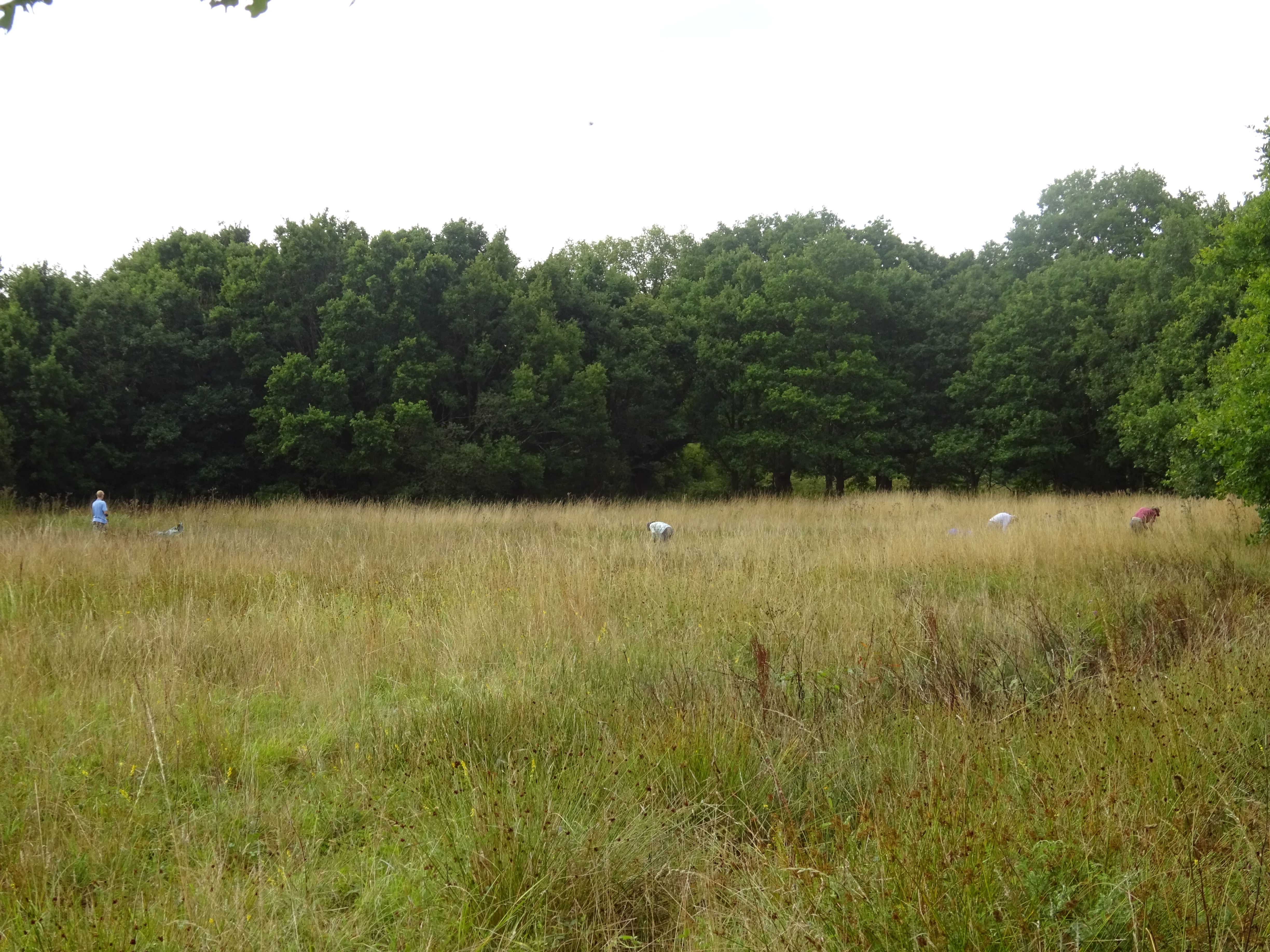 This was a huge task across the whole meadow area but was eventually achieved.
This was a huge task across the whole meadow area but was eventually achieved.
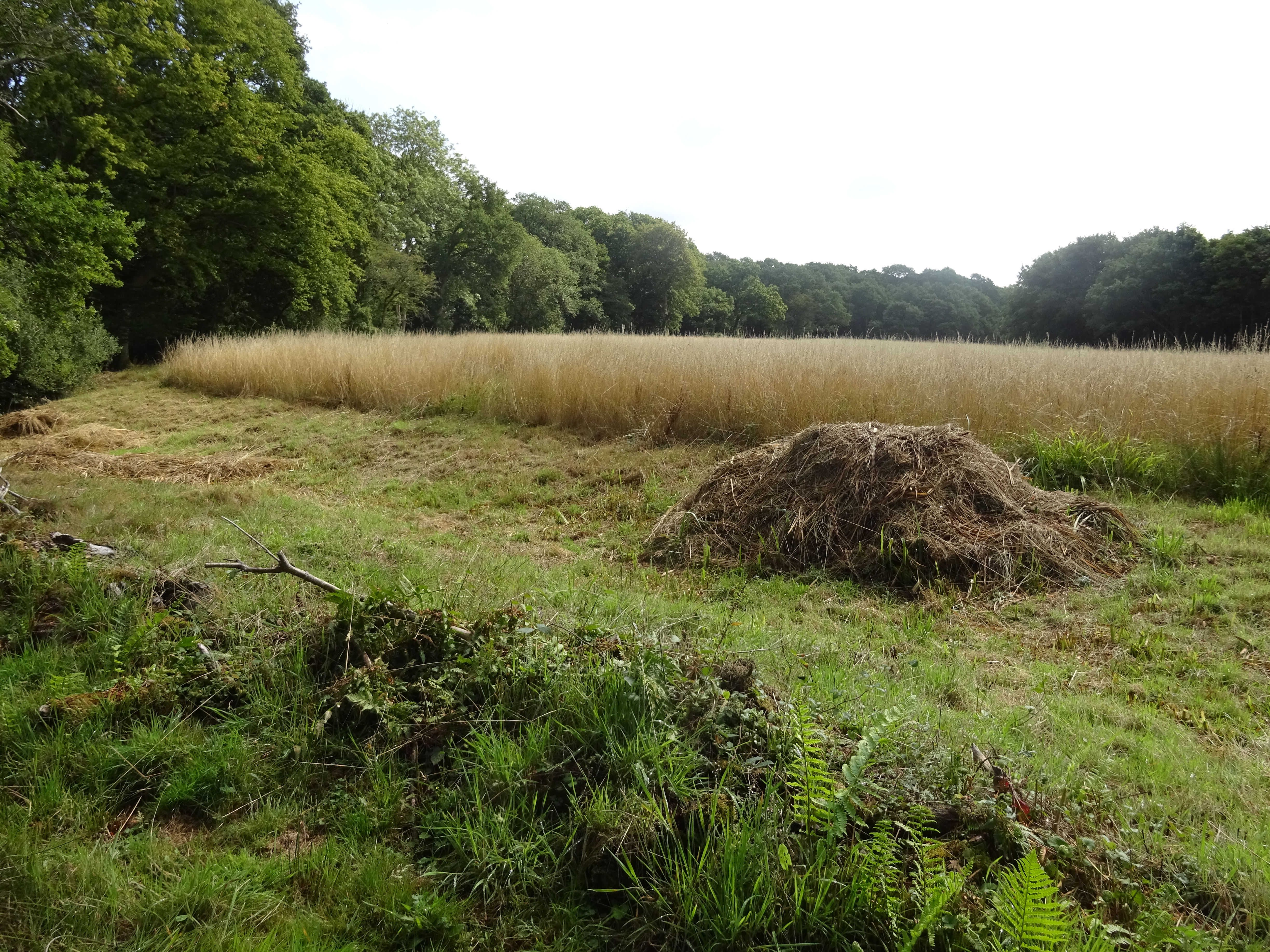 We then turned our attention to clearing the edges of the meadow in readiness for the later meadow cut.
We then turned our attention to clearing the edges of the meadow in readiness for the later meadow cut.
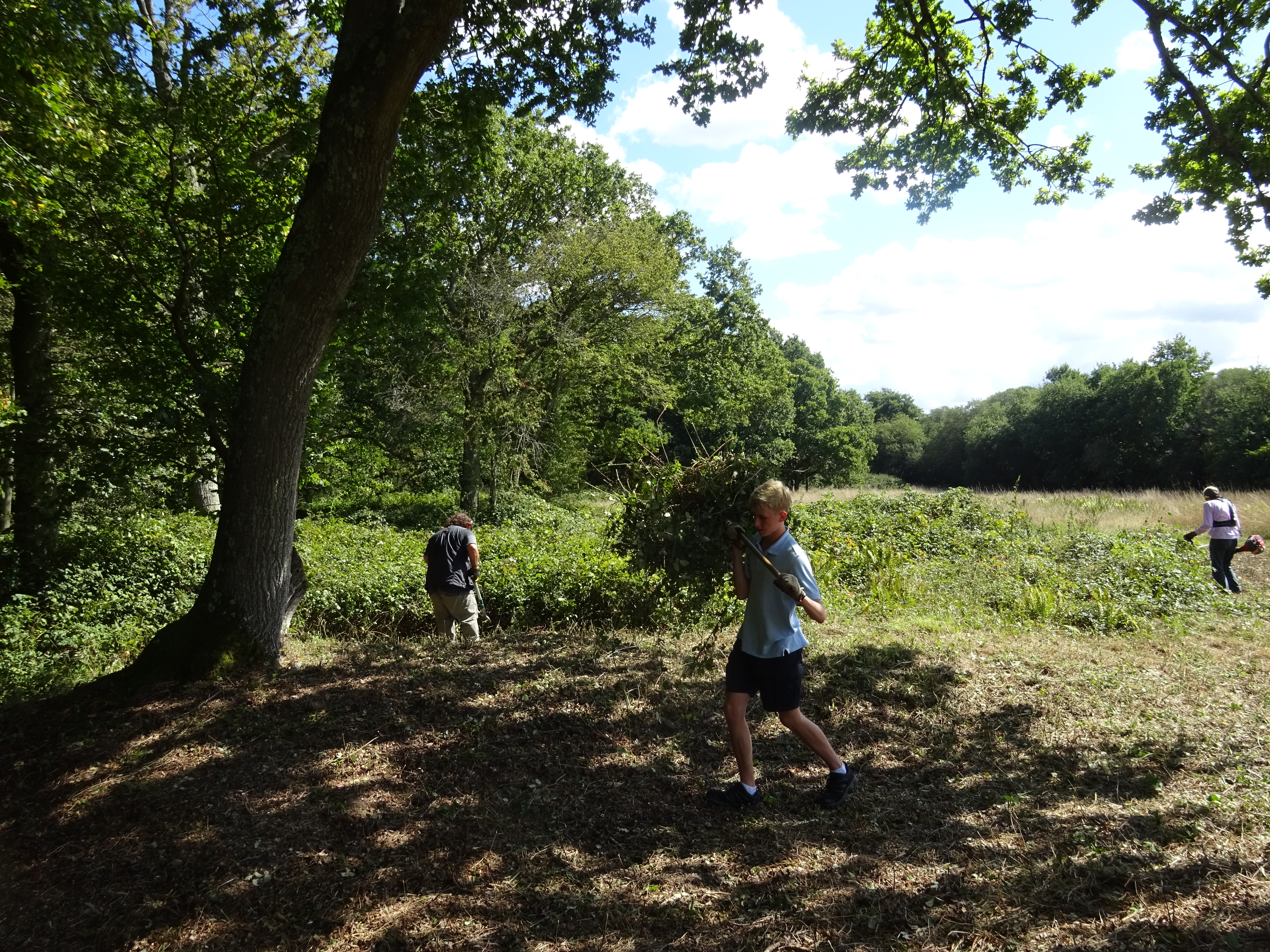 Bramble spread into the meadow area is a constant battle we have to undertake each year.
Bramble spread into the meadow area is a constant battle we have to undertake each year.
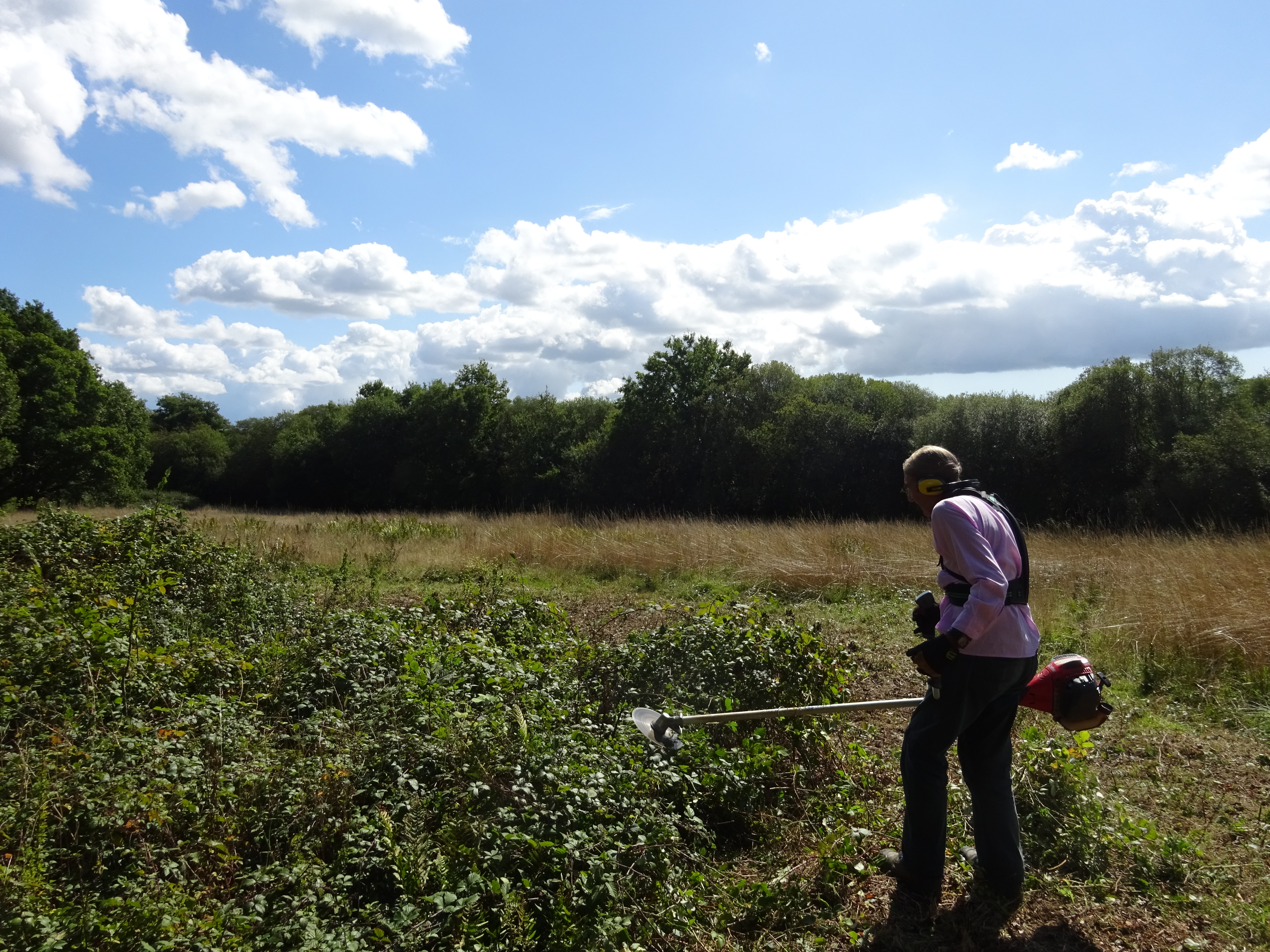 It also obscures ground undulations which the person undertaking the cut has to be aware of for safety reasons.
It also obscures ground undulations which the person undertaking the cut has to be aware of for safety reasons.
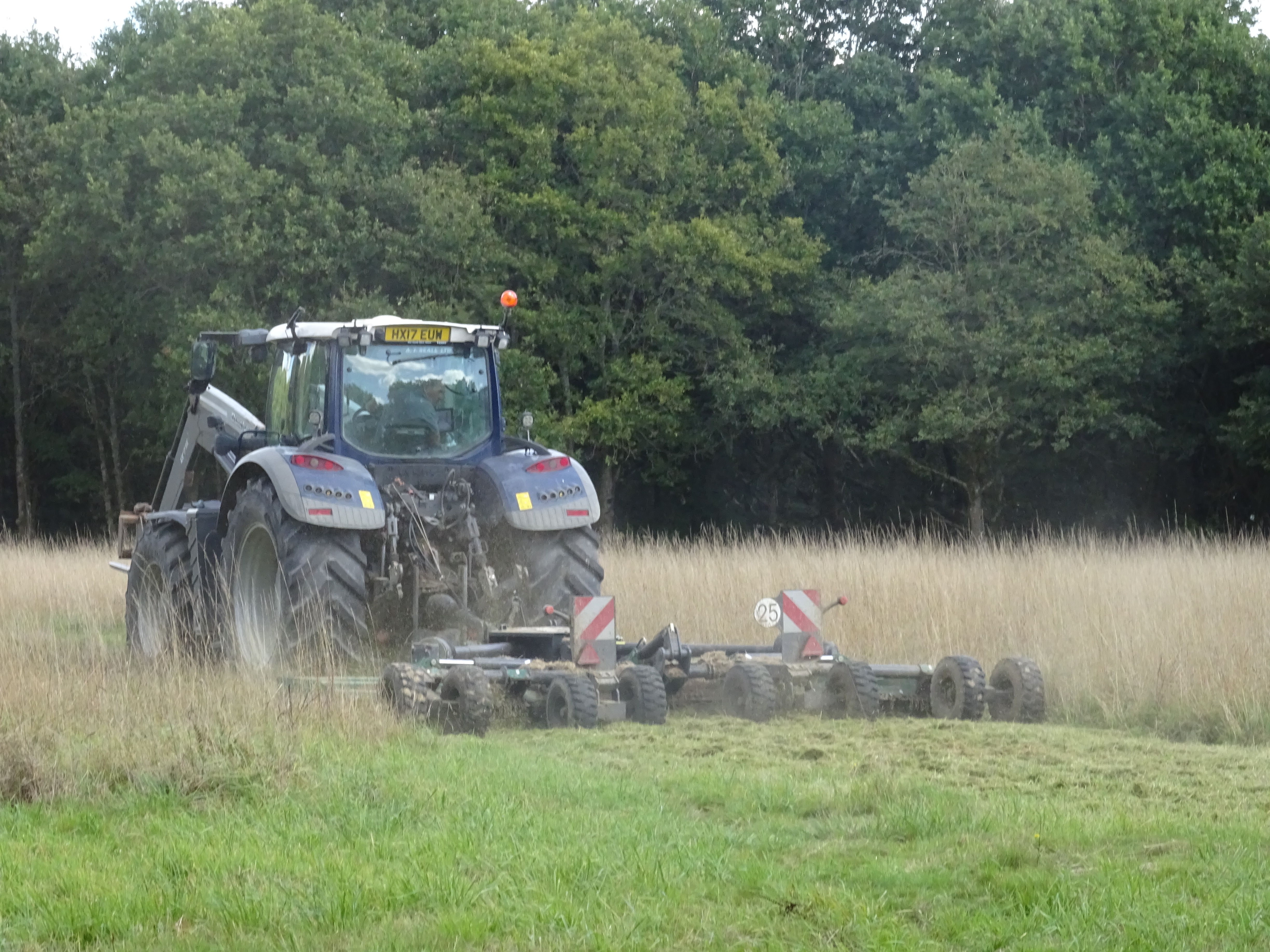 Once this was achieved we advised our valuable volunteer with a tractor and he commenced cutting.
Once this was achieved we advised our valuable volunteer with a tractor and he commenced cutting.
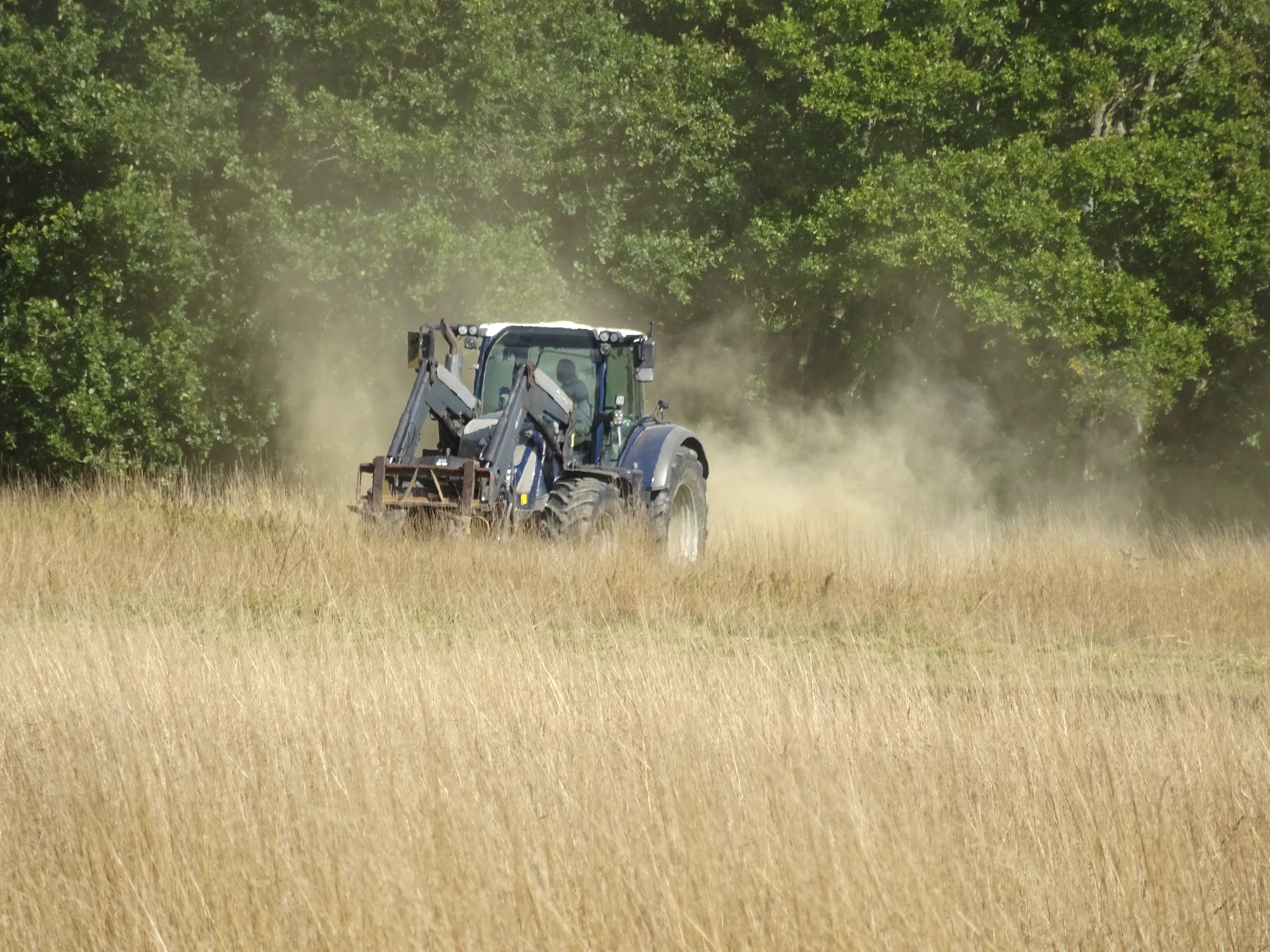 The cut has to be carried out just before the day we receive help from local college students.
The cut has to be carried out just before the day we receive help from local college students.
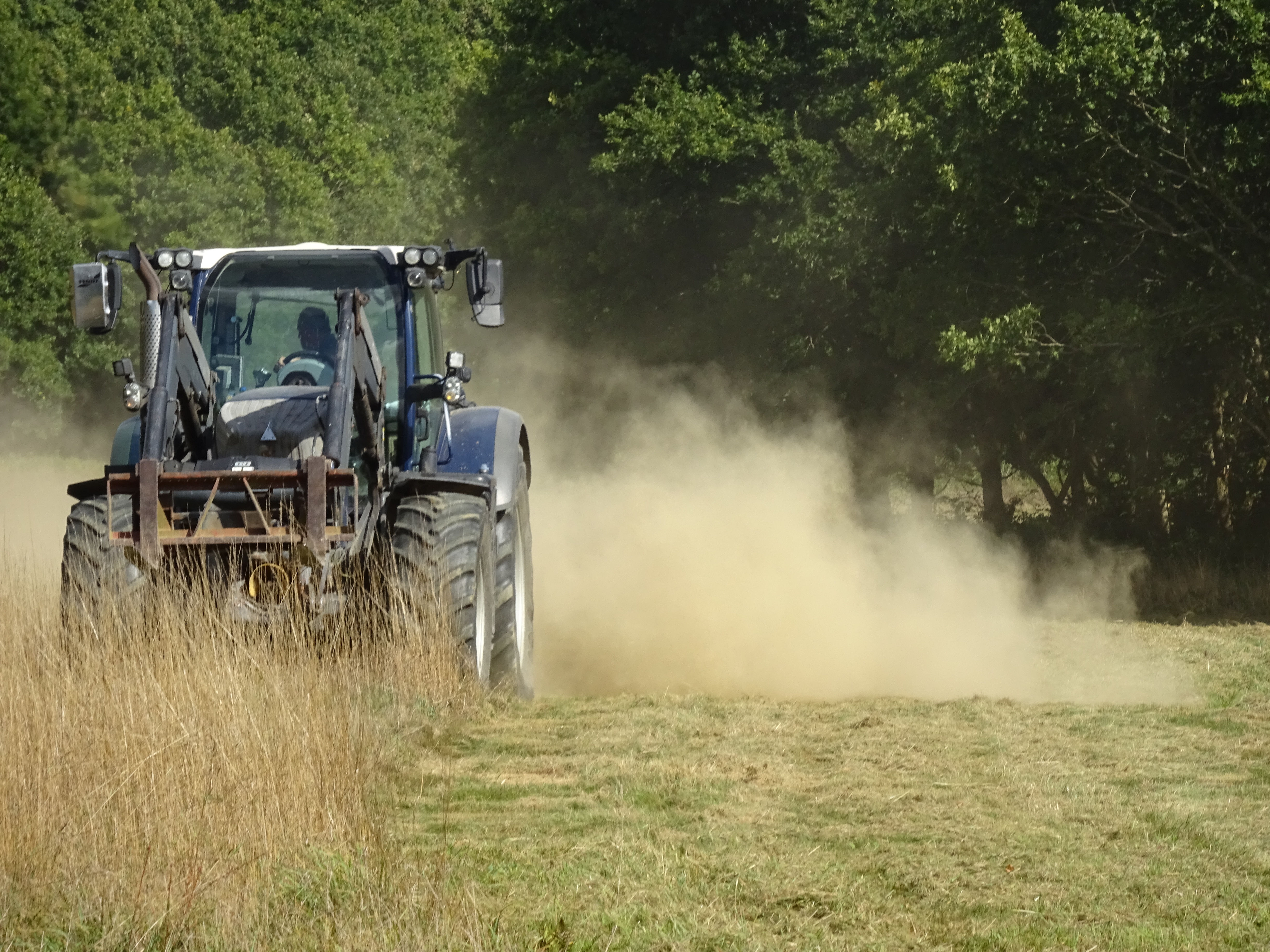 This ensures the cuttings can be gathered up easily.
This ensures the cuttings can be gathered up easily.
 The tractor operator did a fantastic job covering the whole of the large meadow in a couple of hours. This picture shows him finishing the work for which we are hugely grateful for. Without this help we would be slaving away for months doing it by hand.
The tractor operator did a fantastic job covering the whole of the large meadow in a couple of hours. This picture shows him finishing the work for which we are hugely grateful for. Without this help we would be slaving away for months doing it by hand.
 We then arranged for the students to attend quickly afterwards to help us rake up all the cuttings.
We then arranged for the students to attend quickly afterwards to help us rake up all the cuttings.
 They join us every year to lend a hand, and we are very grateful to them also for this help.
They join us every year to lend a hand, and we are very grateful to them also for this help.
 They have become quite familiar with the task and quickly rake the hay into rows.
They have become quite familiar with the task and quickly rake the hay into rows.
 This is then collected up and heaped into piles to be dealt with later.
This is then collected up and heaped into piles to be dealt with later.
 They worked hard for a whole day and achieved a tremendous amount. The disposal of the hay piles and the completion of those areas left unraked would be undertaken later by our group volunteers.
They worked hard for a whole day and achieved a tremendous amount. The disposal of the hay piles and the completion of those areas left unraked would be undertaken later by our group volunteers.
 Following the college volunteer day, our own volunteers gathered to complete the task.
Following the college volunteer day, our own volunteers gathered to complete the task.
 Quickly the piles of hay were disposed of…..
Quickly the piles of hay were disposed of…..
 ….and the remaining area cleared of cuttings. This concluded the huge annual effort surrounding the task to keep the meadow in good condition.
….and the remaining area cleared of cuttings. This concluded the huge annual effort surrounding the task to keep the meadow in good condition.
ANNUAL SPECIAL PUBLIC TALK.
In August each year we hold a special public talk to help us raise much needed funding for our group work. For this we invite a distinguished speaker to share his/her knowledge with the audience. This helps all of us enormously to learn more about the nature or wildlife topic they specialise in. This year a large audience gathered to listen to Keith Kirby, the author & CIEEM medallist for the outstanding lifelong contribution to the advancement of ecology, forestry, and woodland management.
 This talk was held in Hurstpierpoint Village Centre.
This talk was held in Hurstpierpoint Village Centre.
 This picture shows Keith Kirby as he prepared to begin his presentation.
This picture shows Keith Kirby as he prepared to begin his presentation.
 His talk was entitled ‘Woodland Flowers’.
His talk was entitled ‘Woodland Flowers’.
 It appeared to be well-received by the audience, many of whom gathered afterwards to speak to him….
It appeared to be well-received by the audience, many of whom gathered afterwards to speak to him….
 …..and purchase copies of his books.
…..and purchase copies of his books.
 This whole event held each year is a massive undertaking for our volunteers to organise and run, so we are extremely grateful for all their hard work to make it a success. This picture is of one of our group volunteers providing refreshments.
This whole event held each year is a massive undertaking for our volunteers to organise and run, so we are extremely grateful for all their hard work to make it a success. This picture is of one of our group volunteers providing refreshments.
ALBOURNE MILLENNIUM GARDEN.
Later this summer we returned to the Albourne Millennium Garden to check on the usage of the bird boxes we had installed at the end of last year. We examined every box and found that all but one had been used. The occupants had been blue tits and great tits, who were no doubt very grateful for the nesting opportunities provided. Each box was cleaned out and sterilised in readiness for next year’s residents.
 We returned to the Millennium Garden to examine the bird boxes.
We returned to the Millennium Garden to examine the bird boxes.
 All but one of the boxes had been used by the local bird population.
All but one of the boxes had been used by the local bird population.
 The old nests were removed from each box….
The old nests were removed from each box….
 ….and the boxes were sterilised with bird friendly disinfectant to kill any avian infection and harmful bacteria.
….and the boxes were sterilised with bird friendly disinfectant to kill any avian infection and harmful bacteria.
 This was one of the old nests removed.
This was one of the old nests removed.
 When the work was completed the cleaned boxes were left awaiting future bird occupancy.
When the work was completed the cleaned boxes were left awaiting future bird occupancy.
The year has been a very busy one for our group and only a percentage of the activities undertaken have been included in this report. The others will be described in a subsequent ones which will follow in due course. Our supporters and volunteers are of great value to us and essential in supporting our ongoing activities. We therefore strive to keep everyone informed of all work that is carried out by our group.

 Each site is visited…..
Each site is visited….. ….and every box is cleaned out and maintained.
….and every box is cleaned out and maintained. The amount of cleaning out required…..
The amount of cleaning out required….. ….depends on who has occupied it. This one had been utilised by visiting hornets. If squirrels or jackdaws have nested in them, a major effort is required to clear the resulting debris which can completely fill the whole box.
….depends on who has occupied it. This one had been utilised by visiting hornets. If squirrels or jackdaws have nested in them, a major effort is required to clear the resulting debris which can completely fill the whole box. Usually, any occupying barn owl flies out as we erect the ladder.
Usually, any occupying barn owl flies out as we erect the ladder. The winter weather can be very cold with biting winds. It therefore relies on dedicated volunteers to undertake it.
The winter weather can be very cold with biting winds. It therefore relies on dedicated volunteers to undertake it.  Each person fulfils an interlocking role to ensure the work is completed as quickly as possible.
Each person fulfils an interlocking role to ensure the work is completed as quickly as possible. The team visiting this site were not prepared for their findings in this box.
The team visiting this site were not prepared for their findings in this box. The whole farm had been subjected to flailing to remove lower branches on every tree to give clearance to large farm machinery. Note the ripped branches remaining around the box.
The whole farm had been subjected to flailing to remove lower branches on every tree to give clearance to large farm machinery. Note the ripped branches remaining around the box. Although this clearance had missed the box, the regular pair of owls that had been roosting inside…..
Although this clearance had missed the box, the regular pair of owls that had been roosting inside….. ….had been so traumatised that they had both died. The bodies were sent for analysis and confirmed this cause of death. This was such a tragic waste of a healthy, breeding pair of barn owls, but one that typifies the many hazards facing these beautiful creatures in their fight for survival, despite all our efforts.
….had been so traumatised that they had both died. The bodies were sent for analysis and confirmed this cause of death. This was such a tragic waste of a healthy, breeding pair of barn owls, but one that typifies the many hazards facing these beautiful creatures in their fight for survival, despite all our efforts. As only one person can be working up the ladder at any time at each location….
As only one person can be working up the ladder at any time at each location…. ….all other members of the team anticipate their next requirement and are ready to hand this up to them.
….all other members of the team anticipate their next requirement and are ready to hand this up to them.  This allows the task to be completed more quickly, and reduces the amount of time anybody has to stand around waiting for their next role to be performed. In the bleak mid-winter this is obviously of benefit to all.
This allows the task to be completed more quickly, and reduces the amount of time anybody has to stand around waiting for their next role to be performed. In the bleak mid-winter this is obviously of benefit to all. Every box is sited in different terrain, and all team members have to be aware of the requirements for safe working, and ensure all items of equipment to facilitate this are transported to every location.
Every box is sited in different terrain, and all team members have to be aware of the requirements for safe working, and ensure all items of equipment to facilitate this are transported to every location. Much work is required to ensure the boxes are maintained in the best condition. We are therefore regularly disheartened when squirrels occupy the boxes, and reduce them to the condition of this tawny owl box pictured above, with their constant gnawing. It also cost us a lot of money for replacements.
Much work is required to ensure the boxes are maintained in the best condition. We are therefore regularly disheartened when squirrels occupy the boxes, and reduce them to the condition of this tawny owl box pictured above, with their constant gnawing. It also cost us a lot of money for replacements. These were the four barn owl eggs that had been abandoned by the mother last year in one of the boxes we subsequently moved before this year’s breeding season.
These were the four barn owl eggs that had been abandoned by the mother last year in one of the boxes we subsequently moved before this year’s breeding season. The next site was a new location requested for us to survey for installation of one of our boxes by another nature conservation group in Mid Sussex.
The next site was a new location requested for us to survey for installation of one of our boxes by another nature conservation group in Mid Sussex. Having selected the most suitable site in advance, a volunteer working party began clearance work around the tree to begin installation.
Having selected the most suitable site in advance, a volunteer working party began clearance work around the tree to begin installation. The box was then quickly erected by the experienced team of volunteers…..
The box was then quickly erected by the experienced team of volunteers….. ….before finally departing to leave the new accommodation for local owls to discover.
….before finally departing to leave the new accommodation for local owls to discover. We then moved on to another site we had selected for the replacement of established boxes that had become badly damaged in a nearby location. The original site had become a difficult one for the teams to access in safety, so the new ones were fitted in a location very close to it. This box was the first of the pair to be erected.
We then moved on to another site we had selected for the replacement of established boxes that had become badly damaged in a nearby location. The original site had become a difficult one for the teams to access in safety, so the new ones were fitted in a location very close to it. This box was the first of the pair to be erected.  This was the location selected for the second box which was effectively mounted by the members of the team.
This was the location selected for the second box which was effectively mounted by the members of the team.  When the work was concluded, the team members departed leaving the new boxes ready for barn owl roosting and breeding in the season ahead.
When the work was concluded, the team members departed leaving the new boxes ready for barn owl roosting and breeding in the season ahead. Afterwards time was taken to make friends with local neighbours.
Afterwards time was taken to make friends with local neighbours. A further request was received from a local landowner in Hurstpierpoint for a barn owl box to be erected in an agreed suitable location. The team began installing the box on the tree shown above.
A further request was received from a local landowner in Hurstpierpoint for a barn owl box to be erected in an agreed suitable location. The team began installing the box on the tree shown above. The erection was undertaken in managed progressive stages….
The erection was undertaken in managed progressive stages…. ….until final completion was achieved.
….until final completion was achieved. When finished, the team stood back to appreciate the finished installation….
When finished, the team stood back to appreciate the finished installation…. ….before loading all the equipment back onto their vehicles.
….before loading all the equipment back onto their vehicles. The next location requiring attention, was one where the existing landowners had barn owls roosting in boxes in their barn.
The next location requiring attention, was one where the existing landowners had barn owls roosting in boxes in their barn.  With the barn designated for conversion in the near future, we were asked to install boxes on trees nearby to provide alternative accommodation for the regular owl inhabitants. This was the first tree selected.
With the barn designated for conversion in the near future, we were asked to install boxes on trees nearby to provide alternative accommodation for the regular owl inhabitants. This was the first tree selected. The box mounting was speedily completed and we moved on to the second tree.
The box mounting was speedily completed and we moved on to the second tree. The second tree required the clearance of a lot of ivy and interfering branches to make it suitable to mount a box.
The second tree required the clearance of a lot of ivy and interfering branches to make it suitable to mount a box. The team members determinedly undertook the work required….
The team members determinedly undertook the work required…. ….and soon the task was finished. We were very grateful to the landowners for their consideration for the welfare of these local barn owls.
….and soon the task was finished. We were very grateful to the landowners for their consideration for the welfare of these local barn owls. Work then shifted to the installation of a number of tawny owl boxes that had been requested by other landowners in our Mid Sussex Conservation Area. This was the first to be erected by team members.
Work then shifted to the installation of a number of tawny owl boxes that had been requested by other landowners in our Mid Sussex Conservation Area. This was the first to be erected by team members. This was the second, which was quickly completed.
This was the second, which was quickly completed. A further suitable site was selected and the installation of a third box began.
A further suitable site was selected and the installation of a third box began. This was eventually finished….
This was eventually finished…. ….and with work completed for that day, the boxes were left to the local tawny owl population to become familiar with.
….and with work completed for that day, the boxes were left to the local tawny owl population to become familiar with. We returned on a later day to complete a fourth box shown here, that we hadn’t managed to include on the previous visit.
We returned on a later day to complete a fourth box shown here, that we hadn’t managed to include on the previous visit. On a further occasion, a volunteer team was assembled again, and two tawny owl boxes were installed for a landowner in a hillside location in our Southern Mid Sussex Owl Conservation Area. This was one of the boxes erected. A considerable amount of time had been spent beforehand on clearing surrounding foliage, to make the location suitable to meet the tawny owl’s requirements. This clearance exercise was also required before the second box could be mounted.
On a further occasion, a volunteer team was assembled again, and two tawny owl boxes were installed for a landowner in a hillside location in our Southern Mid Sussex Owl Conservation Area. This was one of the boxes erected. A considerable amount of time had been spent beforehand on clearing surrounding foliage, to make the location suitable to meet the tawny owl’s requirements. This clearance exercise was also required before the second box could be mounted.  Further boxes were requested for two landowners in Hassocks. This one was in a woodland where we already had an installation of successful bat boxes. It possessed all the requirements to attract tawny owls.
Further boxes were requested for two landowners in Hassocks. This one was in a woodland where we already had an installation of successful bat boxes. It possessed all the requirements to attract tawny owls.  The box for the second landowner was mounted in woodland on the tree shown.
The box for the second landowner was mounted in woodland on the tree shown.  We now wait to see how successful they are in attracting the required residents.
We now wait to see how successful they are in attracting the required residents.






















































